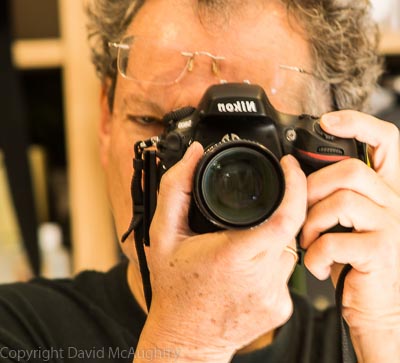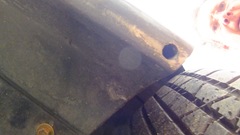Bodywork
The Virage is one of the largest hand-built aluminium cars ever made. You would have thought that this would ensure a long-lasting corrosion free body. Sadly, while this is true for most of the bigger body panels, there are a few points, like the front wings,where corrosion and blistering forms – due largely to elements of the body design. Fortunately, once the critical points are known, some steps can be taken to address the problems. G**ry has of course identified these and I share the information with you below.
The main problem occurs on the leading part of the front wheel arches. The engine air inlets are mounted behind the front bumper unit and are shown below. The large diameter pipe in the centre of the picture leads to the inlet unit which is formed inside the front wing panel.
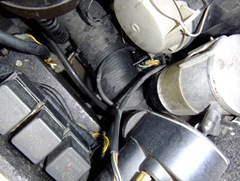 This inlet unit is lined with foam, probably to reduce induction air noise. This padding gradually gets waterlogged, and corrosion starts eating through the thinner paint on the inside of the wing. G**ry’s solution was to trim away the bottom few inches of foam, clean the oxide away, then treat with an etching primer, finally finishing with polyurethane sealant (Sikaflex) to eliminate future corrosion. This work can be done via an access panel inside the wheel arch.
This inlet unit is lined with foam, probably to reduce induction air noise. This padding gradually gets waterlogged, and corrosion starts eating through the thinner paint on the inside of the wing. G**ry’s solution was to trim away the bottom few inches of foam, clean the oxide away, then treat with an etching primer, finally finishing with polyurethane sealant (Sikaflex) to eliminate future corrosion. This work can be done via an access panel inside the wheel arch.
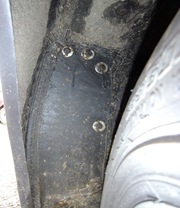 The position of the access panel and its retaining bolts is shown in the photo to the left (the tyre is shown on the right hand side). It’s not worth refurbishing the wing until that work is done in our view.
The position of the access panel and its retaining bolts is shown in the photo to the left (the tyre is shown on the right hand side). It’s not worth refurbishing the wing until that work is done in our view.
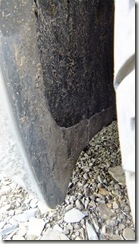 There is an additional problem caused by the wing and spoiler design. The ‘U’ section formed by the spoiler unit at the bottom of the front wing (shown on the left) gets pretty grimy en-route,as it is here, after a run to Scotland. When G**ry took apart the section to do the work described above, he found that fine road grit and dust had filled the whole section to a depth of several inches. This not only provides a base for damp and corrosion, it provides a source of fine particulate dust right below the air intake pipes.
There is an additional problem caused by the wing and spoiler design. The ‘U’ section formed by the spoiler unit at the bottom of the front wing (shown on the left) gets pretty grimy en-route,as it is here, after a run to Scotland. When G**ry took apart the section to do the work described above, he found that fine road grit and dust had filled the whole section to a depth of several inches. This not only provides a base for damp and corrosion, it provides a source of fine particulate dust right below the air intake pipes.
To solve this, G**ry has over drilled the existing drain hole at the base of the front end of the wheel arch, as shown to the left, to ensure the debris can easily exit.
There are a few other sources of water problems that can be addressed with the right information and an air hose. The day of my 50th birthday we set off in the gleaming Aston to Restaurant Troisgros, outside Lyon. Accelerating hard away from our hotel, I was less than pleased to get a complete leg full of water issuing out of the drivers-side scuttle. It turns out there are two drainage tubes on each side at the front of the car – one mounted inside the front bulkhead, and draining the a/c condensate, and another draining the front scuttles. These drainage channels tend to get blocked, and cause the deluge on the leg problem I experienced. They need to be regularly cleared with an air pipe, from the base of the tube upwards.
So there you go. A lot of benefit and increased longevity of the prized aluminium bodywork, plus dryer legs, at a reasonable expenditure of effort. Needless to say, no dealer or specialist has ever mentioned any of these fixes to us.
Other useful pages
- Introduction
- The Virage Engine
- Maintaining the Virage engine
- Bodywork
- Removing water from the Virage petrol tank
- Virage relays – one cause of the one-way journey
- Virage immobiliser – the elusive wiring diagram is tracked down
- Virage – fixing cracked vacuum pipes
- Virage radiator sensors – seals and electrical connections –
- Virage Brakes and Suspension joints
- Virage relays in detail – first place to look if you have over-revving or uneven running problems
- Virage reversing lights/start inhibit
- Virage timing chain tensioner and guide replacement
- Virage fuel filler cap fix – stop water getting into the fuel tank.
- Virage water temperature and throttle sensors – a possible cause of overrunning
- Virage – VIC background, and breakthrough in VIC repair
- Virage VIC – restoring the unit to life
- Detailed instructions on fixing the VIC
